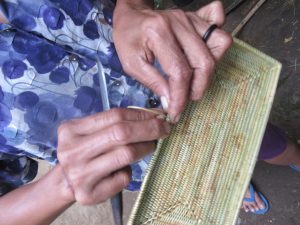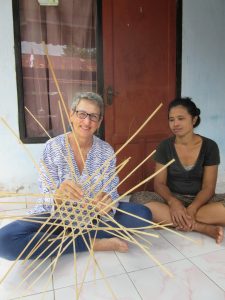
Beautiful Bali
If there’s one place on the planet where basketry techniques and basket making is still integral to the culture, it’s Bali, Indonesia.
But there is also the exquisite coiled weaving with the profuse and wild “ata” vine, which is used to produce everything from restaurant napkin holders, to multi-tiered lunch containers, to betel nut chewing kits.

Ata vine
The weaving strands, sized by pulling them through bottle cap holes of diminishing diameter, are wound around the thick, uncut vine core, and secured to the previous row using an awl; the technique, as well as the patterns, are similar to those used by traditional indigenous cultures here in the U.S.

weaver

weavers

Baskets are everywhere! There are the overturned baskets housing and feeding roosters between cockfights, and the closed baskets with shoulder straps for transporting them on your motorcycle to the fight.

Cock containers

Chicken transport

Temple offering
There are the woven palm leaf pockets used for offerings of steamed rice, and the large offering baskets essential for multiple holiday temple offerings, and for wedding gifts.

Baskets

Baskets

Baskets
Then there are the hexagonal open-weave bushel baskets for commercial use which hold fruits and vegetables in every farmer’s market, and the woven plates, covered by a disposable banana leaf, used for meals.

The Author learning a new technique